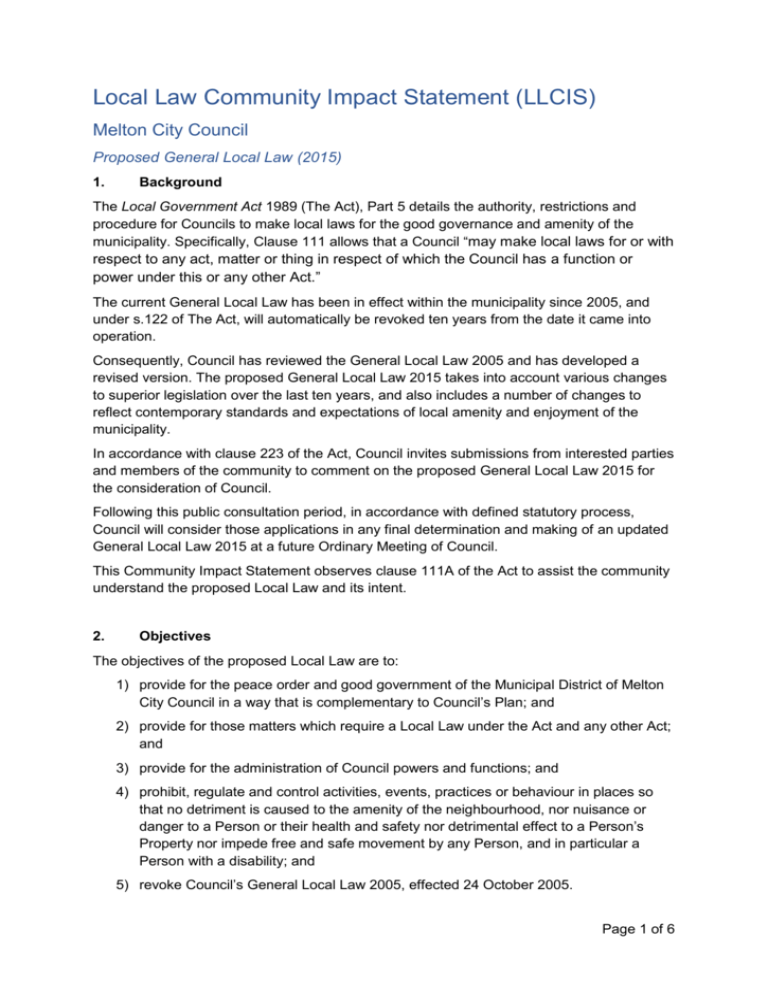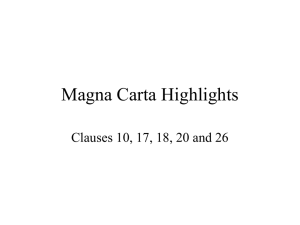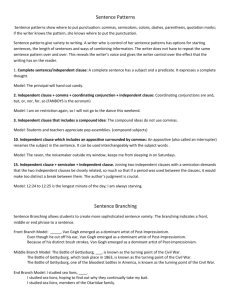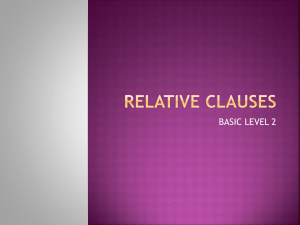Local Law Community Impact Statement (LLCIS) Melton City
advertisement

Local Law Community Impact Statement (LLCIS) Melton City Council Proposed General Local Law (2015) 1. Background The Local Government Act 1989 (The Act), Part 5 details the authority, restrictions and procedure for Councils to make local laws for the good governance and amenity of the municipality. Specifically, Clause 111 allows that a Council “may make local laws for or with respect to any act, matter or thing in respect of which the Council has a function or power under this or any other Act.” The current General Local Law has been in effect within the municipality since 2005, and under s.122 of The Act, will automatically be revoked ten years from the date it came into operation. Consequently, Council has reviewed the General Local Law 2005 and has developed a revised version. The proposed General Local Law 2015 takes into account various changes to superior legislation over the last ten years, and also includes a number of changes to reflect contemporary standards and expectations of local amenity and enjoyment of the municipality. In accordance with clause 223 of the Act, Council invites submissions from interested parties and members of the community to comment on the proposed General Local Law 2015 for the consideration of Council. Following this public consultation period, in accordance with defined statutory process, Council will consider those applications in any final determination and making of an updated General Local Law 2015 at a future Ordinary Meeting of Council. This Community Impact Statement observes clause 111A of the Act to assist the community understand the proposed Local Law and its intent. 2. Objectives The objectives of the proposed Local Law are to: 1) provide for the peace order and good government of the Municipal District of Melton City Council in a way that is complementary to Council’s Plan; and 2) provide for those matters which require a Local Law under the Act and any other Act; and 3) provide for the administration of Council powers and functions; and 4) prohibit, regulate and control activities, events, practices or behaviour in places so that no detriment is caused to the amenity of the neighbourhood, nor nuisance or danger to a Person or their health and safety nor detrimental effect to a Person’s Property nor impede free and safe movement by any Person, and in particular a Person with a disability; and 5) revoke Council’s General Local Law 2005, effected 24 October 2005. Page 1 of 6 3. Comments on the proposed Local Law Measures of Success of Proposed Local Law Council will measure the success of the proposed Local Law by monitoring the effectiveness of the dissuasion and penalty of undesirable conduct and rectification of undesirable impacts on the local community. Legislative Approach The Local Government Act provides Council with the authority to make local laws, while recognising them as subordinate instruments. Consequently, some inclusions within General Local Law 2005 have been removed in recognition of superior legislation that has come into effect over time. The processes for making a Local Law are set out in Part 5, clauses 111-124 of the Act. Risk Assessment Currently in effect, General Local Law 2005 is due to automatically expire under s.122 of The Act on October 24, 2015. To not make a new General Local Law would remove the ability of Council to regulate or prevent many acts considered undesirable by the local community. In the immediate and short term, any absence is likely to be unremarkable or unnoticed, but long term absence would deleteriously impact the liveability and amenity of the municipality. Council will seek public comment prior to deciding whether or not to adopt the proposed Local Law. Restriction of competition No National Competition Policy implications arise. Penalties Penalty provisions apply across 120 infringements, set out in Schedule 1 of the proposed General Local Law 2015. Penalties have been expanded from the existing Local Law, as many infringements currently do not have penalties applied or have insufficient monetary value. This has the effect of severely limiting the deterrence, rectification or punitive impact of breach notices. Council Officers considering that the penalties proposed are sufficient to act as a deterrent for most offences and to reflect the seriousness of those offences. Performance Standards or prescriptive The proposed Local Law does not contain any performance standards. Comparison with neighbouring and like Councils Each Council in Victoria is entitled under the Act to set its own local laws. Charter of Human Rights Council is obliged under the Charter of Human Rights and Responsibilities Act 2006 (the Charter) to act compatibly with human rights, and to consider human rights when making local laws. Part of the process in reviewing the Local Law included a review of Local Laws for neighbouring and like Councils. Council is confident that the substance of the proposed Local Law is of the same or superior standard of General Local Laws made by other Councils. The rights enshrined under the Charter have been fully considered in each clause of the proposed Local Law, which is considered wholly consistent with the general purpose and intent of the Charter. Rights pertaining to property and fair hearing have been appropriately protected within the proposed local law. Page 2 of 6 Consultation meetings Initial consultation has been undertaken with Councillors and staff to identify potential changes and improvements to the proposed Local Law. Amendments to superior statue and regulation have also necessitated changes. Emergency services, including the Victorian Police and CFA were also approached to provide feedback in the development of the proposed General Local Law. Public consultation will be undertaken in accordance with clause 223 of the Act. All submissions and any proposed changes will be considered by Council prior to the Local Law being made. Submissions Submissions are invited from the community in regards to the proposed Local Law in accordance with clause 223 of the Act. Council will undertake the formal submission process once Council has completed its initial research and has adopted a draft for the formal public comment required. There is no set format for submissions but they must be in writing. Persons not able to make a written submission need to contact Council to make alternate arrangements. Council will receive and consider all written submissions, and hear any person making a submission if a person so requests at a meeting of Council or representatives of Council. Council will set a time and place for submission to be heard Page 3 of 6 4. Amendments to the previous Local Law Set out below are details of selected, significant amendments to the existing General Local Law 2015. The following does not comment on any non-substantive changes in which content is essentially duplicated. Extended definitions and preliminary provisions. To update the local law to recognise contemporary legislation, standardise and clarify terminology, and broaden scope to address contemporary amenity issues, the proposed general local law has expanded this section. Updated formatting and arrangement of contents In order to provide for a more accessible and easily understood document in which consistency and standards are applied across all provisions, formatting has been changed and improved. Additionally, content currently applied to respective areas in which application is required more broadly, only one inclusion is proposed. For example, Objection to Notices under existing Local Law s.507, Unsightly and Dangerous Premises, is proposed to be included under Part 8, Enforcement and Permit under the proposed Local Law. Incorporation of Documents Clause 9 of the proposed General Local Law references further documents to be read in conjunction with the Local Law. These include Council’s “Nature strip Guidelines Booklet” and Codes of Practice made under the Prevention of Cruelty to Animals Act 1986, and Domestic Animals Act 1994 respectively. These additional documents will be made available publically following the making of the Local Law under s120 of the Act. Simplified antisocial behaviour restrictions. To prevent duplication and to simplify the local law, several clauses in the current Local Law have been consolidated under Part 3, Behaviour and Use of Roads, Public Places and Council Land including Reserves. Illegitimate use of Council Assets is now treated under Clause 35, Interference with Council Assets. This eliminates provisions relating to antisocial behaviour under current clauses 333, 334, 335, 341, 342 and 352. Removal of Divisions pertaining to respective Council sites. To prevent duplication and simplify the local law, Divisions and references to particular Council sites and facilities have been removed. For example, Division 5, Melton Waves Leisure Centre in the current Local Law has been removed, as consolidated provisions within the proposed Local Law act as a “catch all”. Accordingly, Division 6, Library, within the current local law has also been deleted. However, given the particular nature of the site, Part 7, Division 3 Melton Recycling Facility is a new inclusion. Removal of Council administrative or procedural actions Where administrative or procedural actions are more appropriately and flexibly managed through Council policies, conditions of use and procedures, many have been removed in the proposed Local Law. For example, Membership and Conditions of Borrowing under Division 6, Library, have been deleted. As a further example, matters to which Council must Page 4 of 6 give regard in issuing a Street Trading Permit under cl.402 (3) Street Traders have also been deleted. Special events In order to respond to risk and safety issues arising from events, event planners must now provide Council with risk control measures and plans to ensure the safety and wellbeing of attendees and the public more broadly under clause 50, Special Events. This includes a requirement for appropriate Public Liability Insurance coverage. Garage Sales Currently inadequately managed under the existing Local Law, proposed clause 51 Garage Sales contains controls in relation to location, frequency, hours of operation, signage and obstruction. This will allow Council Officers to appropriately regulate an increasing public amenity issue. Appeals limited to one application Under the current local law, a Notice to Comply for an alleged breach of the Local Law may be appealed twice, firstly to the Authorised Officer as an Objection to Notice under cl.507.3, and then to the Chief Executive Officer under Appeal against Notices under s.507.4. The proposed local law removes the second appeal option, allowing only one right of appeal under cl.106 Objection to Notice to Comply. Prevention and rectification of unsightly, dilapidated and dangerous premises A new clause in response to common complaints in relation to poorly maintained properties, clause 64 Unsightly, Dilapidated and Dangerous Premises compels owners and/or occupants of properties to maintain a minimum standard of appearance in relation to their premises. Authorised Officers may issue a Notice to Comply in instances where the exterior of a building has lapsed into disrepair or been damaged by fire or storm. Authorised Officers may direct corrective action in order to render the property safe or to regain appropriate visual amenity. Penalties apply. Restrictions on storage on private and public land. New clauses 65, 66 and 67 restrict the storage of Shipping Containers, Portable Self-Storage Containers, Heavy Vehicles, Unregistered Vehicles and or Machinery, particularly on residential land or surrounding areas. Penalties apply. Fire Hazards Clause 71 is a new inclusion, responding to significant legislative change over the last decade in regard to emergency management and fire more specifically. This clause outlines responsibilities of property owners in minimising fire risk and mitigating consequence through a number of potential obligations including clearing properties and maintaining fire breaks. Rural property owners face more onerous obligations in line with increased likelihood and consequence of bush fire. Animal Control Part 6, Animal Control, has been significantly altered to simplify and consolidate provisions. Clauses in relation to impounding of animals and power to sell or destroy have been removed in deference to provisions within the Domestic Animals Act 1994 and Livestock Management Act 2010. Terms have been broadened to ensure all animal types are captured by the Local Page 5 of 6 Law, adjustments and new provisions respond to weaknesses which to date have prevented the appropriate censor of inadequate animal control. Clause 80, Animal Litter, expands the responsibilities of owners to remove animal deposits in public places, with penalties now applying. Penalties Penalties have been applied to a far wider range of infringements, and the value of any penalties adjusted to provide either appropriate sanction or dissuasion. Page 6 of 6







